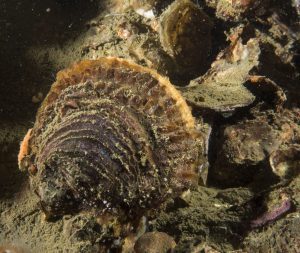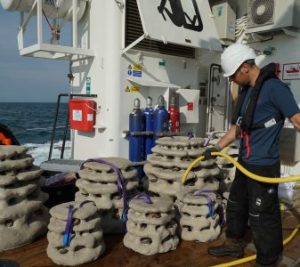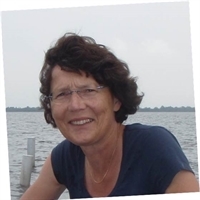European flat oysters back in the North Sea
Wageningen-based researchers are working on the restoration of oyster banks in the North Sea. Like tropical coral reefs, oyster banks form an important link in marine life. To this end, the researchers are conducting trials with European flat oysters at various locations along the North Sea coast. The initial results have been positive.
A century ago, one fifth of the Dutch part of the North Sea bed was covered with banks of European flat oysters (Ostrea edulis). However, due to a combination of overfishing, diseases, pollution and cold winters, European flat oysters virtually disappeared from the North Sea.
The benefits of oyster banks
Worldwide, coral reefs and oyster banks are being restored and protected because of the resulting increased fish production, better water quality, improved soil stability and their contribution to coastal protection. Oysters filter the water, and oyster banks can break the waves and catch soil particles. The oyster banks are also important for the diversity of species in the sea, as breeding grounds, food sources and resting and refuge places. Organisms such as Dead Man’s Fingers (Alcyonium digitatum), a species of soft coral, attach themselves to oyster banks. Sharks, rays, smaller fish and cuttlefish deposit eggs on the shells, and growing fish find food and refuge there. In addition, all kinds of birds are attracted by the many small fish and prawns or shrimps that live on and around shellfish banks. The oysters themselves feed on plankton.
Once they have disappeared from a habitat, it is very difficult for oysters to re-establish themselves. “If there are too few oysters, there is very little chance of successful reproduction,” explains shellfish expert Pauline Kamermans. She works at Wageningen Marine Research, focusing on the restoration of oyster banks.
“ Through the reintroduction or reseeding of oysters and empty shells, we are helping the European flat oyster to form new, viable oyster banks in the North Sea. ”
Change of sex of European flat oysters
Flat oysters are protandric. They start their lives as males. After eight to ten months in seawater of at least 12 degrees Celsius, they become sexually mature. In the third or fourth year, and if the water temperature rises to 15-16 degrees Celsius, they become females. After that, then can alternate between male and female.

Flat oyster in the North Sea. Image by Oscar Bos, Wageningen Marine Research
In the mating season (July to August), the males release sperm into the water. The females pick up the sperm from the water, taking them into their shell cavity – as if ‘breathing in’ the sperm – and thus fertilise their eggs. After one to two weeks, they blow the larvae out from their shell. Initially, these larvae swim around in the upper layers of the water, among the plankton. When they are two to four weeks old, the larvae sink to the seabed. The tiny young oysters must then attach themselves to a hard surface, where they remain for the rest of their lives. Only a few per cent of the larvae succeed in this; the rest die. European flat oysters are suitable for consumption after five to six years, but they can reach twenty years of age and fifteen centimetres across.
Seeding oysters

Artificial reef with oysters. WWF/ARK/onderwaterbeelden.nl
Researchers in Wageningen are now helping oysters to establish themselves. They have joined forces with the consultancy firms Bureau Waardenburg and Sas Consultancy in this regard as the Dutch Flat Oyster Consortium (Platte Oester Consortium, POC), working on projects in collaboration with nature conservation organisations (the Dutch branch of the World Wide Fund for Nature (WWF, WNF), ARK Nature (ARK Natuurontwikkeling), Natuur & Milieu and Stichting De Noordzee) and offshore wind-farm developers (Eneco and Gemini). Pilot projects are now in progress to the north of the Wadden island Schiermonnikoog in the area of the Borkumse Stenen and the Gemini Wind Farm; at the Eneco Luchterduinen wind farm off the coast between Noordwijk and Zandvoort; and in the Voordelta coastal area on the border between the provinces of South Holland and Zeeland, at Brouwersdam.
The Wageningen researchers’ knowledge of the way of life and reproduction of oysters and the innovations in monitoring oysters and oyster banks are indispensable in this respect. The advantage of working on the restoration of nature in the offshore wind farms is that they are not accessible for fisheries that disturb the seabed.
Artificial reef
In the restoration project at the Borkumse Stenen, an artificial reef was first covered with oysters and then sunk to the seabed. In addition, six thousand kilos of oysters were scattered into the water from boxes, and empty mussel shells were dumped as a location for oyster larvae to establish themselves. Agreements were made with fishermen that they will leave this area alone. At the nearby Gemini wind farm, where fishermen are not permitted to fish anyway, a thousand kilos of oysters were seeded. The timing of such actions is crucial given the life cycle of oysters.
Initial results are positive
In the pilot projects, European flat oysters are also sunk in cages. The researchers bring these cages up to the surface again on a few occasions to monitor the development of the oysters. Bureau Waardenburg is investigating the further development of biodiversity, or the restoration of the natural system.
The initial results show that biodiversity seems to be developing well in the Voordelta area. As Kamermans explains, “the special thing about this location is that we as researchers had identified it as a good location for the restoration of oyster banks. As early as 2016, we found a bank of flat and Japanese oysters there. Those wild oysters had probably managed to establish themselves there from Lake Grevelingen (on the other side of the dam), so that confirmed our thinking. We can see that this reef is growing and the oysters are reproducing. Last summer, we built a second bank there. We are also seeing that oysters are surviving and reproducing at the Gemini wind farm and in the Borkumse Stenen area.”
Disease-free oysters
‘Family’ was taken from Lake Grevelingen (on the other side of the dam) for the restoration of the oyster bank in the Voordelta area. These flat oysters naturally have greater resistance to the diseases roaming around there. Disease-free Norwegian oysters were used at the other sites. Shellfish expert Pauline Kamermans and her team are also conducting research into ensuring that local oysters are disease-free. The first results are expected by the end of this year.
Further reading:
- Restoration of European flat oyster reefs in the North Sea and Wadden Sea
- Project De Rijke Noordzee (Windpark Luchterduinen) [in Dutch only]
- Dutch Flat Oyster Consortium (Platte Oester Consortium, POC)
- Read this article in Dutch
Cover image: WWF/ARK/onderwaterbeelden.nl

